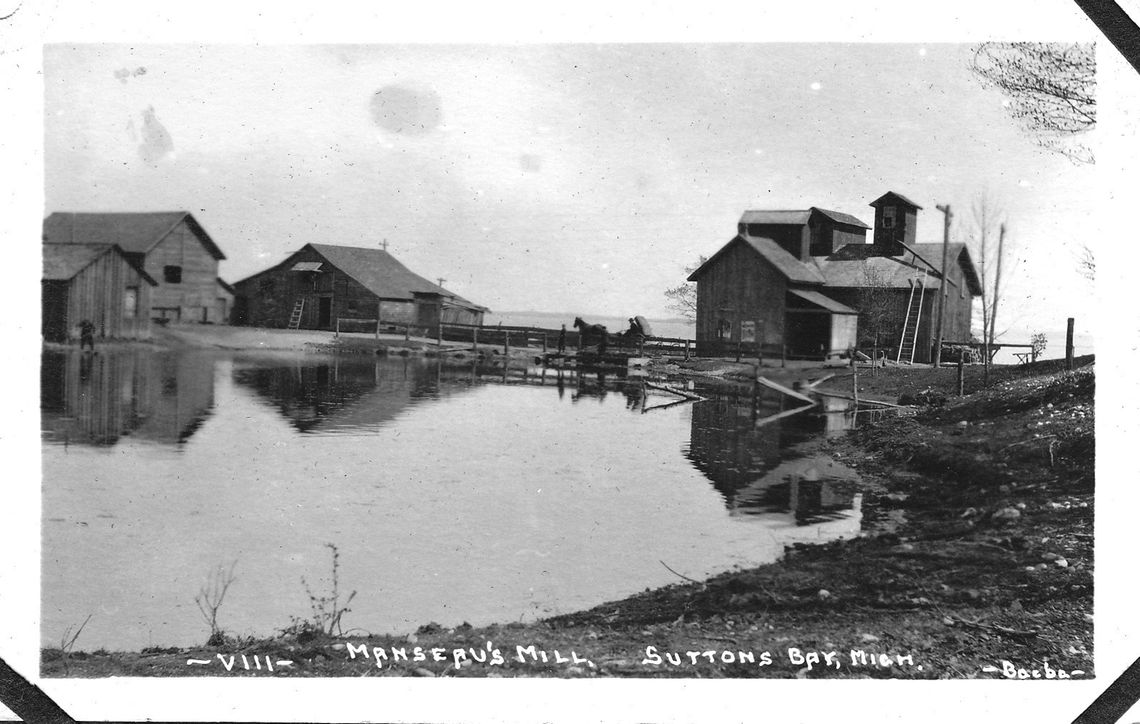Excerpt from the Suttons Bay Sesquicentennial Book.
Laura Lindley’s book includes a profile of Cassimere Boischer & Harriet LeDuc who built their cabin on the shore of Suttons Bay back in 1855. Boischer is remembered as Cassimere Dearwood, his last name being a literal translation from the French.
He was issued the first patent, or deed, for land in this region; he operated the first sailing vessel out of Suttons Bay; and he undoubtedly the first man in the community to entertain a national figure. No less a personage than General Sheridan called on him to discuss the smuggling that was prevalent in the upper lakes at that time . The General was then in command of a government boat that apparently was tracking down smugglers.
Born in Three Rivers, Quebec, on Jan. 25, 1827, he left home at the early age of 14 and spent several years as a salt water sailor and later, on boats that plied the Great Lakes. When the navigation season closed, he wintered in Detroit. It was during one of these off-seasons, in early 1855, that he met and married Harriet LeDuc, a vivacious little French girl of 16 from just across the river in Sandwich, Ontario.
By the time they reached Detroit, ice was forming in Lake Erie, so they wintered in that city. In the spring, Dearwood, then a married man, added his brother-in-law to the ship’s crew and resumed the voyage to New York where DeBelloi had business that consumed much of the summer. So it was October before the schooner returned to Detroit. De Belloi decided to go no farther that season, but Dearwood eager to return to his land, picked up his bride and caught the last steamer for Mackinac Island. At the straits settlement they engaged a fishing boat to take them and their meager belongings to what was to be their homestead on Suttons Bay.
Here on Nov. 7, 1855 they set foot on their own land. With the help of an Ottawa Indian they immediately set about building their log cabin. A big cedar served as shelter while the cabin was being built. Title to the land came June 10, 1856. Curiously, the certificate bears the name of Cassimere DeRoot, instead of Dearwood. That was what the land office clerk understood the young sailor to say when he pronounced the Americanized version of his name in his French accent.
It was a lonely but happy winter the young couple spent in their new home. Their cabin had been made tight against the winter storms. Split hollow logs formed a good roof over their heads. Two small windowpanes admitted light. A packing case served as their first table. Other furniture was fashioned from the cedars all about them.
They found the Indians friendly. At Peshawbestown, a Catholic Mission which they attended, had been established 10 years earlier.
The obtained supplies at the trading post operated by George Keller, on of the earliest pioneers to this region.
The Tom Lees had built a cabin just a few months earlier on adjoining property to the north. It was here that the young wife stayed when spring came and her husband returned to his boat. While staying in the cabin, her first child was born, Aug. 28, 1856. She was the first white girl born in the township. The called her Jane. She became Mrs. Joe Kuemin, Sr., who lived to be 77.
Dearwood hired a small crew of Indians to peel hemlock bark, more for below deck ballast than for cargo although there was a good market for this ark at city tanneries.
The Dearwoods were among the first three of four families to settle in this community. The Suttons preceded them by just a year; Tom Lee by a few months; and perhaps Lorenzo D.
Quackenbush was in this first group. Andrew Palmer an James Lee, for whom Lee’s Point was named, came in 1858. About this time the Bates family moved in from Northport and settled near Quackenbush on land now included in the former Ferdinand Eckerle farm about a mile south of town.
Cassimere and Harriet Boischer Dearwood had nine children. Included among them were Rose Belanger, Katherine Kiessel, Mary Richards, Joseph Dearwood among them.
Rose married Eugene Belanger in 1861. Eugene was a lumberman, farmer and miller. They owned and operated Belanger’s Grist Mill. A railroad track came right to the mill where they shipped out many bags of flour.
Rose and Eugene had 11 children. Grandson Charlie Belanger, now owns and lives at the family homestead.








